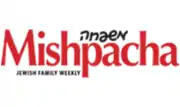Mishpacha
Mishpacha (Hebrew: משפחה, lit.: Family) - Jewish Family Weekly is a Haredi weekly magazine package produced by The Mishpacha Group in both English and Hebrew.
 | |
| Categories | News magazine |
|---|---|
| Frequency | Weekly |
| Circulation | Almost 45,000 copies as of July 2006[1] |
| Publisher | The Mishpacha Group |
| Founder | Eliyahu Paley |
| Year founded | 1984 |
| Based in | Israel |
| Language | English, Hebrew |
| Website | http://www.mishpacha.com/ |
| OCLC | 57819059 |
History
The Mishpacha Publishing Group was founded in 1984 with the publication of the Hebrew Mishpacha magazine. Publisher and CEO Eli Paley teamed with Rabbi Moshe Grylak towards the goal of producing a magazine that would serve as a conduit for the exchange of ideas and values between the varying streams within Jewish orthodoxy,[2] among them the Hasidic, Yeshivish, Sephardic, and Modern Orthodox communities. With no other weekly or monthly magazines geared towards Orthodox Jewish readership at that time, Mishpacha quickly gained popularity, in effect launching the Jewish Orthodox magazine industry.[3]
The first editor for the Hebrew edition was Asher Zuckerman (now the editor of the Hebrew newspaper Sha'ah Tova). First beginning as a monthly, it became a weekly in the beginning of 1991.[1] After a while the newspaper split into two competing weekly papers. One is left with the original name "Mishpacha" and the other is called "Hashavua" (This Week).
According to a TGI (Target Group Index, a subsidiary of market research company Kantar Group) survey of September 2016, the Hebrew "Mishpacha" exposure rate is 24.1%. In light of this, it is the most popular Haredi weekly and weekend in Israel. A magazine "Te'imot" (tasting), which is also published by Mishpacha, is rated 6.7% according to this survey.[4]
In the years 2011–2013, Hebrew "Mishpacha" released a Free newspaper which was distributed in the middle of the week, but its publication was halted due to pressure from the Yated Ne'eman editorial board, which also publishes a free edition in the middle of the week.
English edition
The English Mishpacha launched in 2004 with a weekly package including the flagship Mishpacha Magazine and Mishpacha Junior. Mishpacha was the first full-color weekly magazine targeting the Anglo-Orthodox population worldwide, with the standalone children's magazine also serving as an innovation. Family First, introduced to the package in 2005, was also the first of its kind, a full-color weekly magazine by and for Jewish women.[5]
Mishpacha frequently addresses social problems. For example, it has addressed issues such as the shababniks (Haredi street youth) and violence in the family; and has waged a battle against educational institutions’ discrimination against Mizrahim and the newly religious. But it brings up these issues without mentioning names, so no one will be hurt.[1]
Mishpacha's publications, as a rule, do not print photos of women. There have been rare exceptions to this. For example, when Hillary Clinton was running for president against Donald Trump, the magazine chose to print her face, although very obscured by a blue field.
Some attribute the significant increase in Haredim joining Israel's army to Mishpacha as well as mental health awareness and mental health services access over the past decade amongst Orthodox Jewish populations to the public dialogue stimulated by Mishpacha magazines and other Jewish publications such as Ami.[6][7] Mishpacha has been banned by many rabbinical leaders[8][9] including Rabbi Yosef Shalom Elyashiv.[10] However, Mishpacha has turned to the rabbinical court of the Haredi community (Badatz) which forbade harassment of the magazine.[1] Haaretz, the newspaper of Israel's secular left, describes the Hebrew version of Mishpacha as one of the "most powerful" newspapers in the Haredi community.[11]
References
- Shahar Ilan (July 25, 2006). "In the Family Way". Haaretz. Retrieved January 22, 2018.
- "About Us". Mishpacha. Retrieved January 31, 2019.
- "God, Jews and the Media: Religion and Israel's Media". Routledge. Retrieved April 22, 2015.
- Cohen, Israel (September 5, 2016). "TGI survey for the ultra-Orthodox press: slight strengthening of newspapers, radio slightly weakened". Kikar HaShabbat.
- "Haredi Women's Lit Explodes". Tablet. Retrieved April 22, 2015.
- "Technology Use in the Religious Communities in Israel: Combining Traditional Society and Advanced Communications". Journal of Religion, Media and Digital Culture. Archived from the original on April 22, 2015. Retrieved April 22, 2015.
- "Study: Orthodox Jews More Open To Mental Health Counseling, But Needs Remain". Huffington Post. Retrieved April 22, 2015.
- "The Gedolim's Authority is Tested". Retrieved May 24, 2019.
- "Gedolims' Edicts and Mishpachah". Retrieved May 24, 2019.
- Editor, Y. W. (January 1, 2012). "Maran Rav Elyashiv Calls For A Ban Against Mishpacha Magazine". Retrieved May 24, 2019.CS1 maint: extra text: authors list (link)
- Chizhik-Goldschmidt, Avital (August 11, 2015). "Inside the World of ultra-Orthodox Media: Haredi Journalists Tell It Like It Is". Haaretz. Retrieved August 11, 2015.
External links
- Official website
- Shahar Ilan (July 12, 2006). המשפחה הרביעית [The Fourth Family]. Haaretz (in Hebrew). Retrieved August 21, 2014.